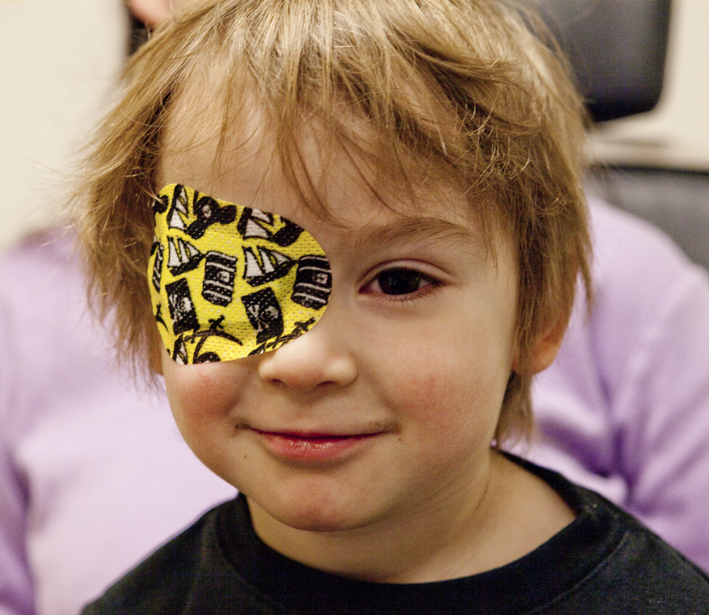 When my parents told me I should walk around with my right eye patched like a pirate—on regular days, not just Halloween—I wondered if they were joking. They weren’t: those really were the doctor’s orders.
When my parents told me I should walk around with my right eye patched like a pirate—on regular days, not just Halloween—I wondered if they were joking. They weren’t: those really were the doctor’s orders.
As a child, I had amblyopia, or “lazy eye”: my left eye had much poorer vision than my right eye. The eye itself was fine, but my brain wasn’t processing information coming from it. The plan was, by patching the “good” eye, to force my brain to use inputs from the amblyopic eye.
Amblyopia affects 2 to 4 percent of the population. In my case, the cause was a common one: strabismus. My two eyes were misaligned and didn’t look at the same thing at the same time.
I was lucky that my parents noticed in time. “The tragedy is that amblyopia gets missed in so many kids when they’re young enough to treat,” says David Hunter, Children’s ophthalmologist-in-chief. Patching works well with young children, but not so well for older kids and adults, who have passed the “critical period” for visual acuity—the window of time when the brain has the most “plasticity,” or ability to change in response to visual experiences.
But the picture for older patients could soon improve. New work from the lab of Children’s neurobiologist Takao Hensch, reported recently in Science, suggests that existing prescription medications might be able to reverse amblyopia well after the critical period is known to end. While this study was conducted in mice, it has spurred a collaboration between Hensch and Hunter that may lead to a clinical trial.
A brake released
Hensch’s lab has been studying amblyopia as a model for understanding the biology of brain plasticity—particularly, critical periods. Led by postdoctoral fellow Hirofumi Morishita, the new study reveals an important control switch: a protein called Lynx, similar in shape to a neurotoxin found in snake venom.
Lynx1 levels rise just as the critical period for visual acuity ends. When Lynx1 is missing, adult mice retain youth-like visual plasticity. If they are amblyopic—from having one eye covered at a young age—they can recover by simply opening the vision-deprived eye.
What’s the magic behind Lynx1? From previous work, the researchers knew that Lynx1 dampens neurotransmission (communication between neurons) via the chemical acetylcholine. Here, by deleting the Lynx1 gene, they are increasing this type of neurotransmission.
Luckily for humans, there are drugs that do the same thing: acetylcholinesterase (AChE) inhibitors such as AriceptTM (donepezil), prescribed for Alzheimer’s disease. Given to adult mice, AChE inhibitors enable amblyopic mice to regain vision. The data are promising enough that Hensch and Hunter are now planning to test such drugs in older children and adults with amblyopia.
In a recent review, Hensch and colleagues list a variety of interventions that increase visual plasticity in adult animals. Many of these—including Lynx 1 deletion and AChE inhibitors—may increase visual plasticity by altering the balance of excitatory versus inhibitory neurotransmission in brain circuits. Early in development, this balance is predisposed towards excitatory messaging; later, inhibitory activity increases. Interventions that shift the balance back toward that in the developing brain may increase plasticity.
AChE inhibitors aren’t the only drugs on the market that alter this excitatory/inhibitory balance in brain activity. Selective serotonin reuptake inhibitors (SSRIs), prescribed for depression, also have this effect. So, in addition to the trial Hensch and Hunter are planning, there may be opportunities to observe patients with amblyopia who are taking these drugs – to see whether their vision improves.
The fun (or zen) factor
Hensch wonders if action-packed video games that motivate older kids and adults to make intense use of their amblyopic eye might enhance the effects of drugs like AChE inhibitors. Perceptual learning methods, or visual tasks that force patients to repeatedly use their amblyopic eye, already exist, and have produced modest gains in vision—typically one to two extra lines on the eye chart.
Recently, researchers at the University of California discovered a more exciting alternative to these tasks—intense video games like Medal of Honor: Pacific Assault. In addition to inspiring patients to do their eye exercises, the games may tap into the very mechanisms by which AChE inhibitors work. “Acetycholine levels in the brain go up with the heightened attention,” Hensch explains. “This can help open the gates to plasticity.”
Intriguingly, acupuncture can also stimulate the release of acetylcholine in the brain. A study from the Shantou International Eye Center in China shows—for the first time in a randomized, controlled trial—that acupuncture can produce visual gains comparable to patching in children with amblyopia.
Lynx, identified deep in the lab, is forging wider links – linking data that before were unconnected, and revealing ways to make new visual links in the brain. The Lynx1 study does more than suggest drugs for amblyopia: It sheds light on how existing therapies might work, and reveals potential new benefits of drugs being prescribed for completely different diseases.







